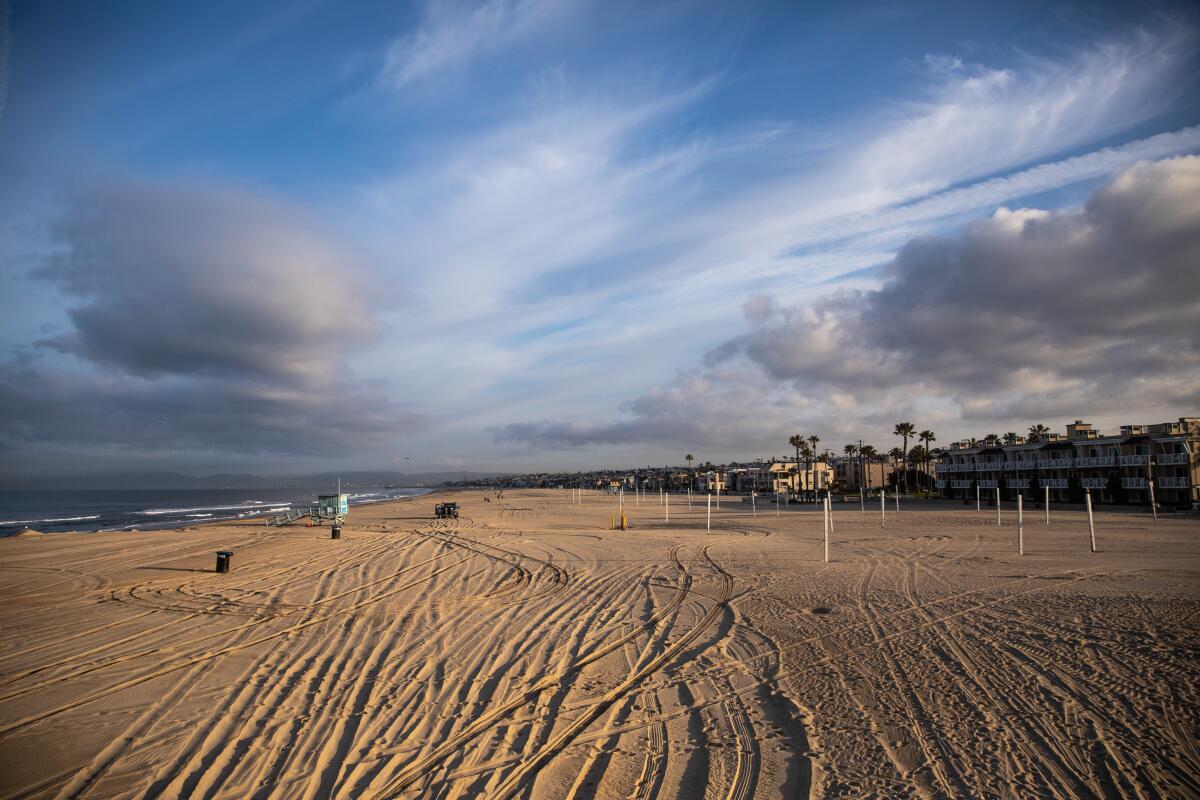When will it actually be safe to go to the beach again?

- Share via
As the weather warms and people start itching to go to their favorite outdoor haunts, Southern California cities are beginning to reopen their recreation spaces. But which destinations should open when and for whom?
Sadly, there’s been no rhyme or reason to the decision making. Take, for example, the way the rules are changing for beaches.
This weekend is going to be a hot one, with temperatures in the 80s and 90s. Ventura County reopened its beaches before the heat wave so people could walk and jog along the water. But Orange County considered closing its beaches during the hot spell to deter sand-starved out-of-towners from flocking there. The county’s Board of Supervisors ultimately decided to leave the beaches open and restrict parking to discourage crowding. But the waterfronts at Laguna Beach and Seal Beach are still locked down, and the coast in Los Angeles County remains off limits.
It’s just as haphazard in Northern California. Last week Santa Cruz reopened its beaches. But in San Mateo County next door, authorities issued parking tickets and warnings to beachgoers who had violated strict rules prohibiting nonessential travel more than five miles from home.
We have sympathy for local leaders who are trying to figure out how to safely reopen beloved public spaces. Most localities closed their beaches, bike paths and hiking trails after a warm, sunny weekend a month ago, when Californians rushed outdoors and flouted social distancing decrees.
Yet it’s also clear that Californians can’t stay cooped up forever. People crave the outdoors. They need it for their mental and physical health. Studies have shown that time spent in nature can lift one’s mood, reduce stress and enhance the immune system. And while we still have much to learn about COVID-19, infectious disease experts suggest there is less risk of spreading the virus outdoors — particularly when people stay six feet apart and cover their mouth and nose.
There’s a value in slowly reopening outdoor recreation spaces. But the decisions and the details should be guided by public health experts. It may require controlling parking or metering access, mimicking how shoppers have to wait in line to enter the grocery store. And cities and counties — and their residents — should be prepared to curtail usage again if the beaches, parks or hiking trails get too crowded for people to socially distance.
That also argues, however, for a more comprehensive approach to reopening public spaces. When so few beaches or trails are open, of course those spaces will get crowded. The crazy quilt of closures and the ad hoc reopenings are confusing and, in some cases, unjust. Who knows which jurisdiction operates which beach and why certain parks are open but others are closed? And if you happen to live close to a beach or a hiking trail, you get the pleasure of using the public space but all others are barred? It’s frustrating for people who want to enjoy the outdoors without breaking the rules.
It was the right decision to close much-loved public spaces to help flatten the coronavirus curve. Now, California communities need to figure out how reopen the beaches, parks and trails safely, equitably and coherently.
More to Read
A cure for the common opinion
Get thought-provoking perspectives with our weekly newsletter.
You may occasionally receive promotional content from the Los Angeles Times.









